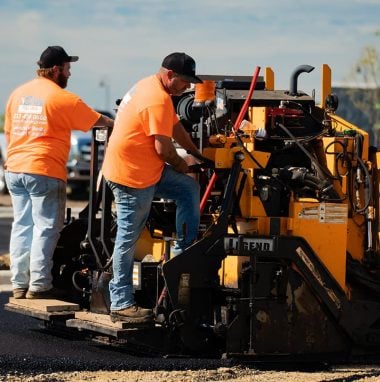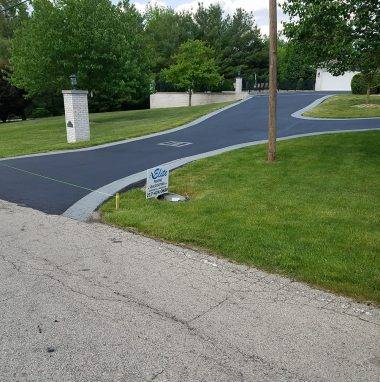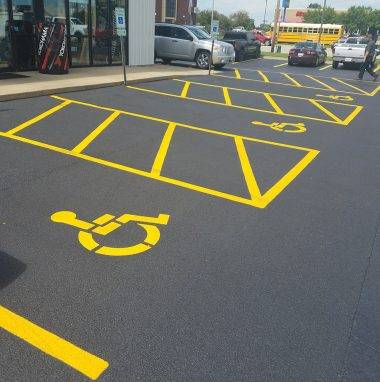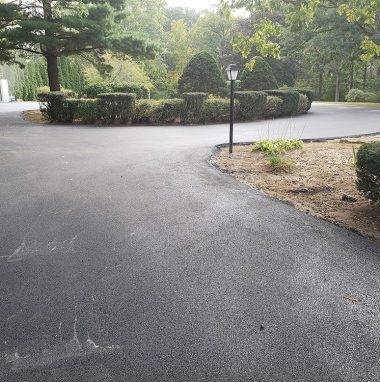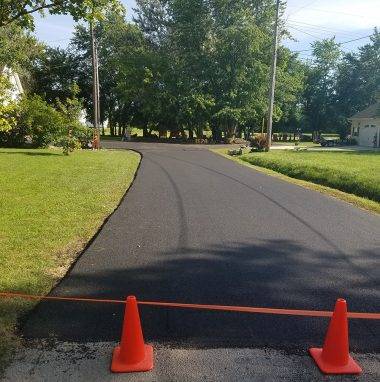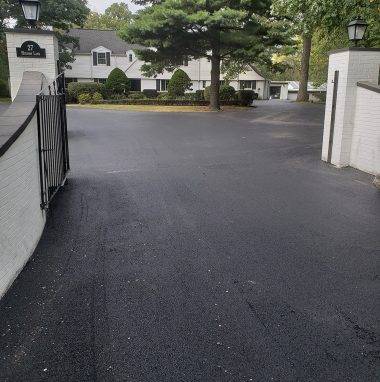Sealcoating Champaign, IL
Asphalt Overlay vs. Sealcoating
Your asphalt driveway looks excellent, but you’re starting to notice a few cracks here and there on its surface. Unfortunately, these seemingly minor issues can become a significant problem if you don’t fix them as soon as possible. There are typically a few ways to correct or prevent asphalt problems – asphalt overlays or a sealcoating applied directly to your asphalt 24 hours after the surface has completely cured.
Both of these methods can provide many benefits for your driveway or parking lot but have some drawbacks that must be considered. The following information will help you better understand the benefits and disadvantages of both types and when you should implement them on your asphalt. Make sure to talk to an asphalt expert about these methods if you find your driveway or parking lot is in rough shape.
What is an Asphalt Overlay?
An asphalt overlay is a slightly different approach than sealcoating, one that focuses on a specific patch of asphalt rather than the whole surface. Typically, this method is used to fix up cracks and potholes that have yet to become too severe. These issues don’t require replacement of the whole asphalt, which is why an overlay is used instead. This process is also relatively simple to implement in most cases.
For example, a new overlay will add a thin layer of hot asphalt to the existing surface of your driveway or parking lot. Once the pavement is poured, it gets evened out to create a smooth driving surface. After several hours of drying, the asphalt is typically hard enough to drive on safely. However, you may want to wait 24 or more hours to ensure that the asphalt cures appropriately before driving.
This method typically fixes any surfaces problems on your asphalt very quickly and provides you with a long-lasting surface that will look great for years to come. The many benefits of this approach, however, are balanced by a few common issues that may pop up from time to time. These concerns don’t outweigh the benefits but should be fully understood before you get an overlay.
Overlay: Positives and Negatives
An asphalt overlay is a better choice than sealcoating if you already have cracks or breaks on your surface pavement. They are designed to fix these issues and to keep your surface strong. However, asphalt overlays aren’t quite a miracle cure for all asphalt-related damage. There are several situations in which they simply aren’t a good choice for your driveway or parking lot.
For example, an asphalt overlay should be considered only a surface-level or cosmetic improvement on your driveway or parking lot. Unfortunately, more severe cracks – such as those that move through the whole surface of an asphalt slab – aren’t fixed very well with overlays. Even worse, problems with the subbase cannot be fixed with overlays, which can complicate their application in many ways.
Another issue is the fact that overlays may wear away over a period of a year or two. Their surface protection won’t completely disappear, but the cracks beneath the surface may work their way to more visible exposure. In a way, an overlay is like a bandage – while it can help with minor cosmetic problems and promote better repairs, it doesn’t quite work for more severe or widespread damage.
What is Sealcoating?
A sealcoat works differently than an asphalt overlay because it is more of a preventative method than a repair technique. For example, you typically apply a sealcoat to your pavement after you wait 24 hours for its surface to cure. Once the sealcoat is applied, you usually wait another 24 hours before you drive on its surface again. During this wait, the sealcoat works its way into the asphalt to make it stronger.
A sealcoat can protect your pavement from heat-related damage, including direct exposure to UV rays. Even better, a sealcoat can waterproof the surface of your driveway to prevent water-related damage. These benefits vary depending on how much sealcoat you apply and where you use it, but it should be uniform if you get this process done from a high-quality professional that you can trust.
Once you apply a sealcoat to your driveway or parking lot, you shouldn’t have to use another coat for a lengthy period. In this way, you can avoid spending too much money on maintenance or other repair procedures. However, there are a few drawbacks of this approach that you should understand. These drawbacks don’t make a sealcoat a bad investment but should be followed so that you don’t apply a sealcoat inappropriately or ineffectively.
Sealcoating: Positives and Negatives
A sealcoat is a great protective barrier that will last 3-4 years, depending on how well you maintain it. Maintenance includes cleaning its surface and a few other spot repairs that don’t take a lot of time or investment. However, a sealcoat is a treatment that cannot and should not be used to fix or repair cracks in the surface of your pavement. Simply put, that’s not the purpose of this care method.
Instead, an asphalt sealcoat should be used to prevent this type of damage before it occurs. If you are smart and regularly upgrade your sealcoat over the years, cracks and breaks should never happen. However, poor maintenance could cause cracks to pop up, and a new sealcoat cannot fix the damage. It can, however, keep the damage from getting worse by preventing expanding cracks.
Although this drawback isn’t a huge one – there are other asphalt repair methods you can use for this purpose – it is something that you need to consider. For example, you might buy a can of sealcoat and apply it to your driveway to fix cracks and end up wasting your time and money. An overlay is a better choice when cracks appear, though more complete repairs should be considered as well.
Expert Advice is Available
By now, you should have a pretty good idea of what type of repair method you want to use for your pavement. Each of these methods provides extra support that makes them worth the investment, so make sure that you fully understand them before you make a decision.
If you’re still not sure which one you want to use on your driveway, please don’t hesitate to contact us at Elite Paving & Sealcoating right away to learn more about how we can protect your pavement in Champaign, IL or the surrounding Central Illinois area. Our experts will pair you up with the best repair method for your driveway or parking lot and execute in a simple and effective way.
